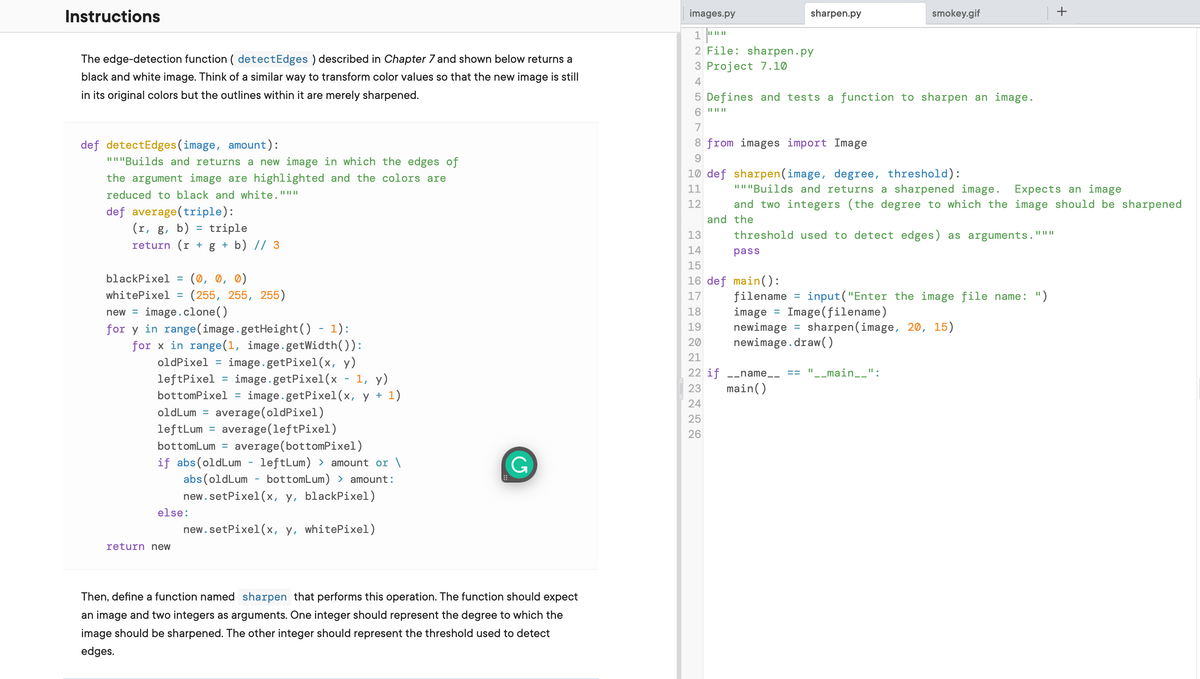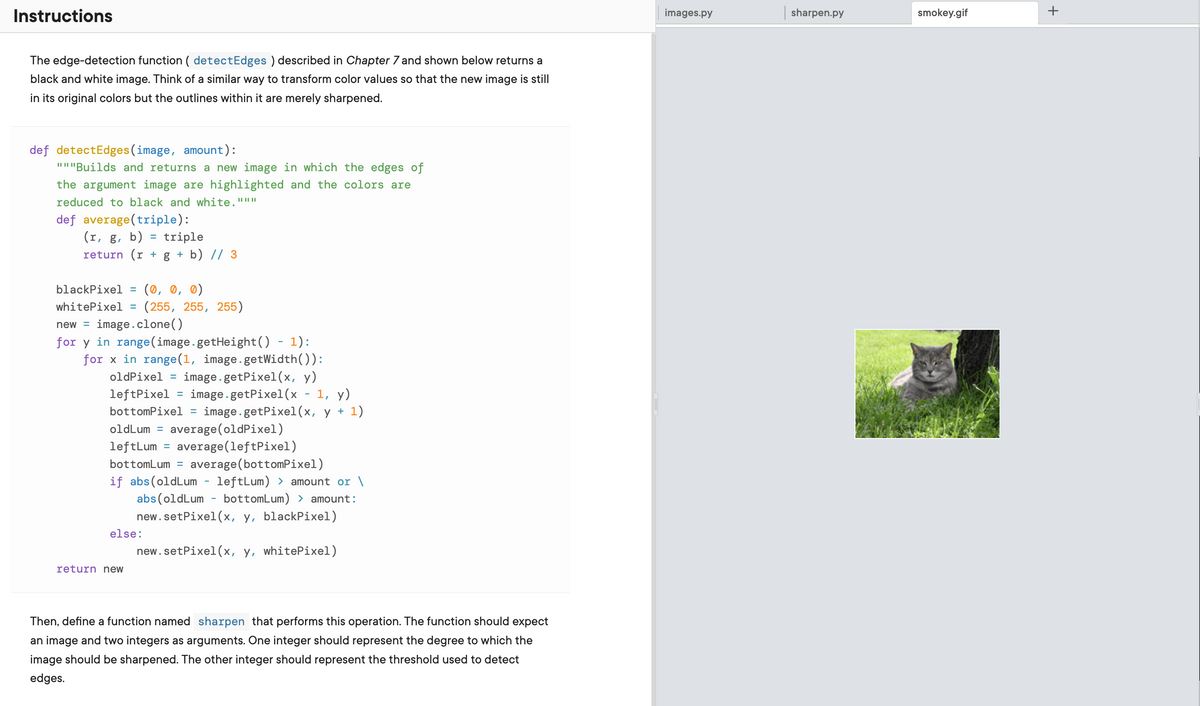PLEASE SOLVE THANK YOU
Database System Concepts
7th Edition
ISBN:9780078022159
Author:Abraham Silberschatz Professor, Henry F. Korth, S. Sudarshan
Publisher:Abraham Silberschatz Professor, Henry F. Korth, S. Sudarshan
Chapter1: Introduction
Section: Chapter Questions
Problem 1PE
Related questions
Question
100%
PLEASE SOLVE THANK YOU

Transcribed Image Text:Instructions
The edge-detection function (detect Edges ) described in Chapter 7 and shown below returns a
black and white image. Think of a similar way to transform color values so that the new image is still
in its original colors but the outlines within it are merely sharpened.
def detectEdges (image, amount):
"""Builds and returns a new image in which the edges of
the argument image are highlighted and the colors are
reduced to black and white."""
def average (triple):
(r, g, b)
= triple
return (r + g + b) // 3
blackPixel = (0, 0, 0)
whitePixel = (255, 255, 255)
new = image.clone()
for y in range(image.getHeight() - 1):
for x in range(1, image.getWidth()):
oldPixel = image.getPixel(x, y)
leftPixel = image.getPixel(x - 1, y)
bottomPixel = image.getPixel(x, y + 1)
oldLum = average (oldPixel)
left Lum average (leftPixel)
bottomLum= average (bottomPixel)
if abs(oldLum - leftLum) › amount or \
abs(oldLum - bottomLum) > amount:
new.setPixel(x, y, blackPixel)
new.setPixel (x, y, whitePixel)
else:
return new
G
Then, define a function named sharpen that performs this operation. The function should expect
an image and two integers as arguments. One integer should represent the degree to which the
image should be sharpened. The other integer should represent the threshold used to detect
edges.
images.py
|| || ||
1
2 File: sharpen.py
3 Project 7.10
4
sharpen.py
5 Defines and tests a function to sharpen an image.
6 "|||||
7
8 from images import Image
9
10 def sharpen(image, degree, threshold):
11
12
13
14
15
16 def main():
17
18
19
20
21
22 if __name__
23
main()
24
25
26
smokey.gif
"""Builds and returns a sharpened image. Expects an image
and two integers (the degree to which the image should be sharpened
and the
threshold used to detect edges) as arguments. """
pass
=
filename =
image
newimage =
newimage.draw()
input("Enter the image file name: ")
Image (filename)
sharpen (image, 20, 15)
"__main__":
+

Transcribed Image Text:Instructions
The edge-detection function (detect Edges) described in Chapter 7 and shown below returns a
black and white image. Think of a similar way to transform color values so that the new image is still
in its original colors but the outlines within it are merely sharpened.
def detectEdges (image, amount):
"""Builds and returns a new image in which the edges of
the argument image are highlighted and the colors are
reduced to black and white."""
def average (triple):
(r, g, b) = triple
return (r + g + b) // 3
blackPixel = (0, 0, 0)
whitePixel = (255, 255, 255)
new = image.clone()
for y in range(image.getHeight() - 1):
for x in range(1, image.getWidth()):
oldPixel = image.getPixel (x, y)
1, y)
leftPixel image.getPixel (x
bottomPixel = image.getPixel(x, y + 1)
oldLum= average (oldPixel)
average (leftPixel)
left Lum
bottomLum = average (bottomPixel)
if abs(oldLum - left Lum) > amount or \
abs(oldLum - bottomLum) > amount:
new.setPixel(x, y, blackPixel)
new.setPixel(x, y, whitePixel)
else:
return new
=
=
Then, define a function named sharpen that performs this operation. The function should expect
an image and two integers as arguments. One integer should represent the degree to which the
image should be sharpened. The other integer should represent the threshold used to detect
edges.
images.py
sharpen.py
smokey.gif
+
Expert Solution
This question has been solved!
Explore an expertly crafted, step-by-step solution for a thorough understanding of key concepts.
This is a popular solution!
Trending now
This is a popular solution!
Step by step
Solved in 3 steps with 1 images

Knowledge Booster
Learn more about
Need a deep-dive on the concept behind this application? Look no further. Learn more about this topic, computer-science and related others by exploring similar questions and additional content below.Recommended textbooks for you

Database System Concepts
Computer Science
ISBN:
9780078022159
Author:
Abraham Silberschatz Professor, Henry F. Korth, S. Sudarshan
Publisher:
McGraw-Hill Education

Starting Out with Python (4th Edition)
Computer Science
ISBN:
9780134444321
Author:
Tony Gaddis
Publisher:
PEARSON

Digital Fundamentals (11th Edition)
Computer Science
ISBN:
9780132737968
Author:
Thomas L. Floyd
Publisher:
PEARSON

Database System Concepts
Computer Science
ISBN:
9780078022159
Author:
Abraham Silberschatz Professor, Henry F. Korth, S. Sudarshan
Publisher:
McGraw-Hill Education

Starting Out with Python (4th Edition)
Computer Science
ISBN:
9780134444321
Author:
Tony Gaddis
Publisher:
PEARSON

Digital Fundamentals (11th Edition)
Computer Science
ISBN:
9780132737968
Author:
Thomas L. Floyd
Publisher:
PEARSON

C How to Program (8th Edition)
Computer Science
ISBN:
9780133976892
Author:
Paul J. Deitel, Harvey Deitel
Publisher:
PEARSON

Database Systems: Design, Implementation, & Manag…
Computer Science
ISBN:
9781337627900
Author:
Carlos Coronel, Steven Morris
Publisher:
Cengage Learning

Programmable Logic Controllers
Computer Science
ISBN:
9780073373843
Author:
Frank D. Petruzella
Publisher:
McGraw-Hill Education